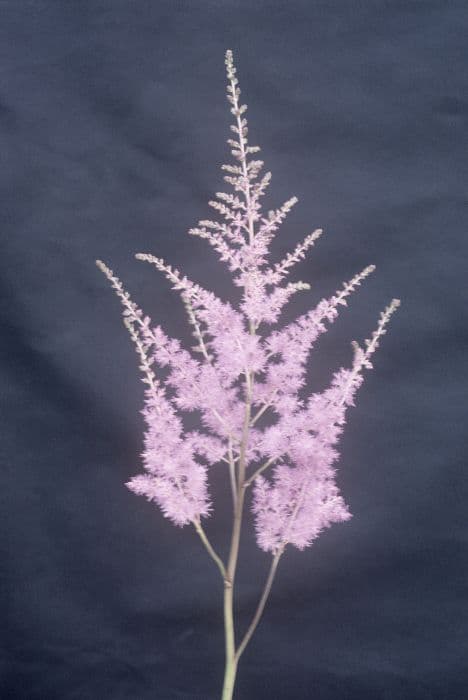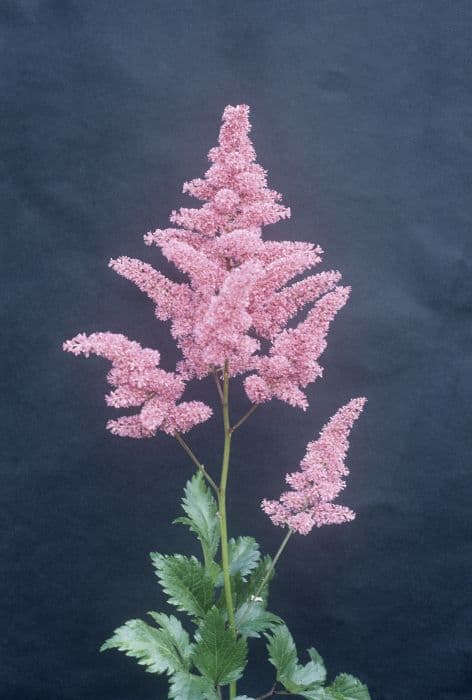Purple Saxifrage Saxifraga 'Splendens' (oppositifolia) (7)

ABOUT
The Saxifraga 'Splendens', also known as Purple Mountain Saxifrage, boasts an appearance that is both delicate and eye-catching. This plant forms a low-growing, compact cushion of tiny, bright green leaves, which are rounded and arranged neatly in a dense rosette. These leaves create a lush backdrop for the vibrant flowers that emerge in a dazzling display. The flowers of the Purple Mountain Saxifrage are notably striking, with each blossom comprising five rounded petals that come together to form a saucer-like shape. The petals are an intense shade of purple, a deep and rich color that can vary from plant to plant, sometimes showing with hints of pink or red. At the center of these flowers, there is typically a contrasting burst of yellow, resulting from the prominent stamens that attract pollinators. The overall effect of the Purple Mountain Saxifrage in bloom is one of a carpet of stunning purple set against the verdant green of its foliage, creating a display that is both elegant and robust. Despite its delicate appearance, the plant is known for its hardiness and its ability to thrive even in challenging conditions.
About this plant
 Names
NamesFamily
Saxifragaceae.
Synonyms
Splendid Saxifrage, Purple Saxifrage, Purple Mountain Saxifrage, Opposite-leaved Saxifrage.
Common names
Saxifraga oppositifolia var. splendens, Saxifraga splendens.
 Toxicity
ToxicityTo humans
The Purple Saxifrage is generally not considered to be toxic to humans. There are no well-documented cases of poisoning, and it is not typically associated with adverse effects upon ingestion. However, as with any plant, individual allergies or sensitivities may occur, so it is always advisable to exercise caution and avoid ingesting plants that are not known to be edible.
To pets
The Purple Saxifrage is not known to be toxic to pets. It is not listed among plants that are commonly harmful to animals such as dogs and cats. However, individual pets might have specific sensitivities, and plant ingestion can sometimes lead to gastrointestinal upset or other non-specific symptoms. It is always best to prevent pets from eating ornamental plants as a precaution.
 Characteristics
CharacteristicsLife cycle
Perennials
Foliage type
Evergreen
Color of leaves
Green
Flower color
Pink
Height
0.1 feet (3 cm)
Spread
0.5 feet (15 cm)
Plant type
Herb
Hardiness zones
3
Native area
Europe
Benefits
 General Benefits
General Benefits- Ornamental appeal: Saxifraga 'Splendens', commonly known as Purple Mountain Saxifrage, offers vibrant purple flowers that enhance the aesthetic of gardens and landscapes.
- Alpine garden suitability: As an alpine plant, it is well-suited for rock gardens and alpine collections where it can thrive in conditions similar to its natural mountain habitats.
- Low maintenance: Requires minimal care once established, making it a convenient choice for gardeners looking for low-maintenance plants.
- Cold hardiness: It is hardy in cold climates, making it a great choice for gardens in cooler regions.
- Ground cover: It can serve as an effective ground cover, providing erosion control on slopes and banks.
- Bee-friendly: The flowers attract pollinators, such as bees, which are essential for the health of the ecosystem.
- Long blooming period: Purple Mountain Saxifrage typically has a long flowering period, offering color and interest in the garden over an extended time.
 Medical Properties
Medical Properties- This plant is not used for medical purposes.
 Air-purifying Qualities
Air-purifying QualitiesThis plant is not specifically known for air purifying qualities.
 Other Uses
Other Uses- The leaves of Saxifraga, commonly known as Purple Mountain Saxifrage, can be pressed and used in botanical art, providing an enduring representation of the plant's beauty.
- Purple Mountain Saxifrage can serve as an indicator species in ecological studies, helping researchers assess the health of alpine environments where it naturally grows.
- The plant’s tendency to thrive in cracks and crevices makes it a useful tool in studies on plant colonization and succession in harsh environments.
- Purple Mountain Saxifrage can be used in rock gardens to demonstrate natural alpine flora for educational purposes.
- Its vibrant flowers can be used as a natural dye for fabrics, providing a soft and subtle color palette.
- The cushion-like growth habit of Purple Mountain Saxifrage has been studied for its potential applications in green roofing technologies.
- Purple Mountain Saxifrage’s ability to grow in high-altitude areas makes it a candidate for research on climate change and its effects on mountain ecosystems.
- This plant can be used in frost-resistant landscaping designs, thanks to its tolerance of extreme cold temperatures.
- Fine art photographers have been known to use Purple Mountain Saxifrage as a subject to capture the essence of alpine environments and the concept of survival in harsh conditions.
- Purple Mountain Saxifrage can inspire artists and designers looking to replicate the texture and resilience of alpine plants in their work, such as in miniature garden designs or eco-friendly architecture.
Interesting Facts
 Feng Shui
Feng ShuiThe Purple Saxifrage is not used in Feng Shui practice.
 Zodiac Sign Compitability
Zodiac Sign CompitabilityThe Purple Saxifrage is not used in astrology practice.
 Plant Symbolism
Plant Symbolism- Resilience: The Saxifraga, commonly known as Saxifrage, has the ability to grow in cracks of rocks and withstand harsh environmental conditions, symbolizing endurance and the ability to thrive amidst adversity.
- Tenacity: Its vigorous nature and the way it clings to its habitat is emblematic of persistence and determination.
- Adaptation: Saxifrage adjusts to different terrains and altitudes, representing flexible adaptation to life's circumstances.
 Water
WaterFor Purple Mountain Saxifrage, water sparingly, as this plant is adapted to alpine conditions and does not require frequent watering. Typically, watering once a week during its active growth period in the spring and summer is sufficient, providing about one gallon of water per plant to moisten the soil. In fall and winter, reduce watering to once every two weeks, or less if the plant is in a cold environment, to prevent root rot. Ensure that the plant has well-draining soil and use room temperature water to avoid shocking the roots.
 Light
LightPurple Mountain Saxifrage thrives in partial shade to full sun, making it versatile and adaptable to various lighting conditions. The best spot for this plant would be where it receives morning sunlight and is protected from the intense afternoon sun, or in a location where it gets dappled shade throughout the day. Avoid placing it in deep shade, as this can impede its growth and flowering.
 Temperature
TemperaturePurple Mountain Saxifrage is cold-hardy and can tolerate a wide temperature range. It prefers temperatures between 60 to 75 degrees Fahrenheit but can withstand temperatures as low as 20 degrees Fahrenheit. Ideal conditions are cooler, alpine-like environments, which mimic its natural habitat. Avoid prolonged exposure to temperatures above 80 degrees Fahrenheit, as this could cause stress to the plant.
 Pruning
PruningPrune Purple Mountain Saxifrage in the late spring or early summer to maintain its shape and encourage new growth. Remove any dead or damaged foliage and cut back leggy stems. Pruning is generally not needed frequently, but performing this task once a year can help stimulate blooming and keep the plant looking its best. Always use clean, sharp scissors or pruners to avoid damaging the plant.
 Cleaning
CleaningAs needed
 Soil
SoilPurple Mountain Saxifrage prefers a gritty, well-draining soil mix with a slightly acidic to neutral pH, usually between 5.5 and 7. A mix composed of equal parts sharp sand, loam, and peat or compost would be ideal to provide the necessary drainage and nutrients.
 Repotting
RepottingPurple Mountain Saxifrage should be repotted every two to three years to refresh the soil and accommodate root growth. This also helps to clear away any compacted soil and reintroduce nutrients.
 Humidity & Misting
Humidity & MistingPurple Mountain Saxifrage thrives in moderate humidity levels, but being an alpine plant, it is also quite tolerant of lower humidity environments. Consistency in humidity is more important than high humidity levels.
 Suitable locations
Suitable locationsIndoor
Place in bright, indirect light with cool temps.
Outdoor
Ensure well-draining soil, partial sun, and cool temps.
Hardiness zone
3-7 USDA
 Life cycle
Life cycleSaxifraga oppositifolia, also known as Purple Mountain Saxifrage, begins its life cycle as a seed that germinates in cold climates, often in rocky, well-drained soils. After germination, it develops into a small rosette of fleshy, spoon-shaped leaves, remaining close to the ground to resist harsh conditions. This perennial plant enters a vegetative stage, producing stems and leaves during spring and summer, and may form mats as it grows. Once mature, typically in late spring to early summer, it blooms with striking purple flowers, which attract pollinators necessary for sexual reproduction. After pollination, flowers develop into capsules containing seeds that are dispersed by wind or water, completing the cycle. Throughout its life, Saxifraga oppositifolia may also propagate asexually through offsets, contributing to the thick mats often observed in its natural habitat.
 Propogation
PropogationPropogation time
Spring-Early Summer
The most popular method for propagating Saxifraga oppositifolia, commonly known as Purple Mountain Saxifrage, is through division. This is typically done in the spring as new growth appears or in late summer after the blooming period has ended. To propagate by division, carefully lift the parent plant from the soil, ensuring to keep a good amount of root intact. Then, using your hands or a clean, sharp knife, gently separate the plant into smaller sections, each with a portion of root and several shoots. Replant these divisions into well-draining soil at the same depth they were growing previously and water them well. It's important to keep the new plants well-watered until they are established, which usually takes a few weeks. This method allows gardeners to create new plants quickly, maintaining the characteristics of the parent plant.









